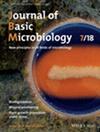Optimized Production and Characterization of Auxin by Bacillus amyloliquefaciens (TSP11) for Plant Growth Promotion
Abstract
This study was aimed at isolating and recognizing the plant growth promoting rhizobacteria that secretes indole-3-acetic acid/auxin hormones. Among the 82 pure cultured bacterial morphotypes, the strain TSP11 showed high auxin production utilizing rice husk as a cheap substitute in the production medium. The minimal medium supplemented with 0.1 g/mL L-tryptophan and 1.29% rice husk produced the highest amount of auxin. Synthesized auxin was purified and quantified by chromatographic techniques. 120.08 µg/mL of synthetic medium and 135 µg/mL of agro-waste medium were the observed yields in HPLC quantification. Further GC-MS/MS and LC-MS/MS spectra exposed an existence of derived compounds such as 1H-indole, 7-methyl, indole, 3-methyl-, 1H-indole-3-carboxaldehyde (1H-indol-3-YL)-acetic acid. It was characterized by X-ray diffraction to reveal its crystallinity. Thermo gravimetric analysis showed the thermal stability of auxin over the range between 200°C and 300°C. Structural predictions of extracted auxin through HR-NMR revealed chemical shifts for Indole and acetate derivatives. The potent producer was identified as Bacillus amyloliquefaciens strain TSP11based on 16SrDNA gene sequencing. Increased seed germination percentage was observed when compared to untreated control. The research findings explore the possibility of exploiting B. amyloliquefaciens strain TSP11for bioformulations. This study represents an initial investigation into the plant growth-promoting potential of B. amyloliquefaciens strain TSP11, particularly regarding its auxin production using rice husk as a medium. We will explore the exact mechanism of auxin synthesis and its impact on various plant species in further studies.

 求助内容:
求助内容: 应助结果提醒方式:
应助结果提醒方式:


